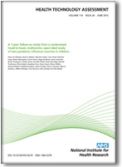
Clinical & economic effects of K-wire & volar locking-plate fixation for radial fractures

Clinical & economic effects of K-wire & volar locking-plate fixation for radial fractures
UK DRAFFT: a randomised controlled trial of percutaneous fixation with Kirschner wires versus volar locking-plate fixation in the treatment of adult patients with a dorsally displaced fracture of the distal radius
Health Technol Assess. 2015 Feb;19(17):1-124Did you know you're eligible to earn 0.5 CME credits for reading this report? Click Here
Synopsis
461 patients with dorsally displaced distal radius fractures were randomized to undergo either volar locking-plate fixation or K-wire fixation. This study aimed to prove, through comparison, the null hypothesis that Patient-Reported Wrist Evaluation (PRWE) scores do not vary between treatments. The primary outcome of interest was PRWE results and secondary outcomes included DASH functional scores,...
To view the full content, login to your account,
or start your 30-day FREE Trial today.
FREE TRIAL
LOGIN
Forgot Password?
Explore some of our unlocked ACE Reports below!

Learn about our AI Driven
High Impact Search Feature
Our AI driven High Impact metric calculates the impact an article will have by considering both the publishing journal and the content of the article itself. Built using the latest advances in natural language processing, OE High Impact predicts an article’s future number of citations better than impact factor alone.
Continue



 LOGIN
LOGIN

Join the Conversation
Please Login or Join to leave comments.